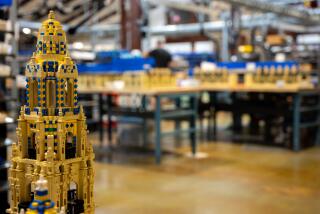Tribeca 2014: In ‘Beyond the Brick,’ Lego as cultural juggernaut
NEW YORK -- “The Lego Movie” this winter reawakened many people to the colorful plastic bricks they hadn’t thought about since childhood. But a raft of people inside and outside the Danish company have been clued in to its pleasures for years, as a new movie gleefully and sometimes astonishingly documents.
The film, “Beyond the Brick,” which premiered at the Tribeca Film Festival several days ago, is a playful if decidedly soft-lensed look at all things Lego. Directed by Daniel Junge and Kief Davidson and narrated by Jason Bateman, “Brick” looks at the subculture of Lego — or perhaps, given how dominant it appears to have become, the culture of Lego.
As “Brick” demonstrates, hundreds of thousands of fans build and tinker in their homes, then commune over the Internet or at regular “Brick Cons” — gatherings of like-minded souls who obsess over pieces and creations the way superhero fans immerse themselves in Comic-Con.
PHOTOS: Tribeca Film Festival 2014 | Scene
“I was surprised most by at how Lego brings people together,” said Davidson in an interview, which included Junge. “When we first set out to make the movie, it seemed like something people do on their own. But it really is a way for people to connect.”
Known for more serious fare (Junge won an Oscar for his doc “Saving Face” while Davidson was nominated for “Open Heart”), the filmmakers started this project after looking into a film on just one Lego convention before realizing there was a larger story to tell. They also, like many of its potential viewers, have been reconnecting to the colorful bricks via the young people in their lives.
They eventually reached out to the company, which, in the spirit that also had them open up to Hollywood with its first-ever feature, was willing to cooperate.
The directors’ examination of the quirky company can be somewhat light. The movie does cover Lego Group’s rough period -- foundering in the 1990s as it scaled back the building aspects of its product and had yet to discover wide-scale licensing deals — but mostly emphasizes the creativity and open-sourced attitude that has made it the second-biggest toymaker in the world, with the company sometimes employing designs of its fans and even hiring a few. (The filmmakers, who hope the movie can strike a theatrical-release deal, said Lego gave them autonomy and had only minor factual notes after seeing a rough cut for the first time last month.)
VIDEO: Tribeca Film Festival 2014 trailers
But it’s the Lego devotees who form the movie’s spine: the AFOLs (Adult Fans of Lego) and others who obsess and build. (Lest one think it’s a geeks-only pursuit, the filmmakers also show some unlikely devotees, including Dwight Howard of the NBA’s Houston Rockets.)
The uses of Lego are surprisingly wide-ranging, as the film shows. The bricks are seen being put to use in everything from autism therapy to urban planning. But most striking are the fans — a man who creates Lego art, the famous Lego moviemakers (who have made numerous films in a kind of brick-happy spin on Claymation) and just the everyday people who build massive constructions.
Among those is Alice Finch, a prize-winning builder who has created sprawling replicas of the Lord of the Rings world, including a Lego-scaled Rivendell she made out of 200,000 bricks. The suburban mom was at the premiere earlier this week, and she said she’s currently working on another Tolkien-inspired world.
“I’m running out of room,” she said at the screening. “We’re actually thinking of remodeling our attic so I have more space.”
PHOTOS: Behind the scenes of movies and TV
Nor is it just the size of these projects that impresses; several show remarkable Rube Goldberg-like ingenuity, with a series of moving balls or even a replica of a Mars Rover.
Junge said he took note of the sheer possibilities.
“What struck me, and what we wanted to show, is the almost-infinite possibilities that can come from a small group of bricks,” he said. (The film explores this, as a Danish mathematician tries to devise a formula to tabulate the number of possible creations with just a handful of standard-sized bricks and finds that they number in the hundreds of millions for just six or seven bricks -- and that even calculating the possibilities of eight or nine would take decades.)
Like the product it covers, “Brick” is an interesting creation. It taps into the same interest that both got the Lego movie made and turned it into a hit. If there’s any doubt about the pervasiveness of the product (it has become, clearly, much more than a toy), a fact at the beginning of the film dispels it: There are more than 100 Lego pieces for every person on the planet.
Lego may seem like an anomaly, a tangible, analog item in a digital world. But as the movie says, building is in our DNA. It’s what’s being built that remains so remarkable.
More to Read
Only good movies
Get the Indie Focus newsletter, Mark Olsen's weekly guide to the world of cinema.
You may occasionally receive promotional content from the Los Angeles Times.










